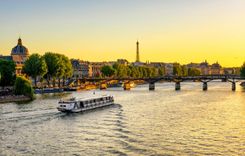The best area in Paris to stay for a central area: Marais
- My recommendation: Hotel Meslay Republique
- Location: Right bank of the Seine, spanning parts of the 3rd and 4th arrondissements
- Pros: Charming historic architecture, trendy boutiques, and vibrant nightlife
- Cons: Can be crowded and noisy, especially on weekends
Full of splendid old mansions, narrow lanes, designer boutiques and buzzing bars and restaurants, the Marais is one of Paris’s more striking quartiers. This chic district also holds a slew of sleek galleries, and the old Jewish quarter centred on rue des Rosiers. You'll also find here a number of excellent museums, not least the splendid Musée Picasso.
The Centre Pompidou’s radical “inside-out” architecture looks just as ground-breaking as it did when it first opened in the 1970s, and its modern art museum is a knockout.
The opening of the Centre Pompidou gave rise to some violent reactions. Since then, however, it has won over critics and the public alike. Architects Renzo Piano and Richard Rogers freed up maximum space inside by placing all infrastructure outside.
The transparent escalator on the front of the building, giving access to the Musée National d’Art Moderne, affords superb views over the city.
Why I love it: My favourite part of Marais is the Place des Vosges, at the eastern end of rue des Francs-Bourgeois. It is a masterpiece of aristocratic elegance. I just love the symmetrical pink brick and stone mansions built over arcades.
Where to stay in this area
- Best for couples: Hotel Meslay Republique. This intimate hotel offers cosy rooms and a romantic atmosphere perfect for a Parisian getaway.
- Best for history buffs: Hôtel De Nice. Housed in a 17th-century building, this hotel captures the essence of old-world Paris with modern amenities.
- Best for art lovers: Hotel Rivoli. Surrounded by galleries and museums, this stylish hotel is ideal for those looking to immerse themselves in the Marais art scene.
Or browse hundreds of accommodations in Marais at any budget.
















